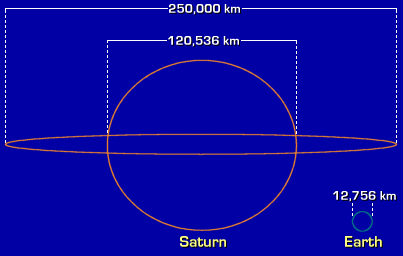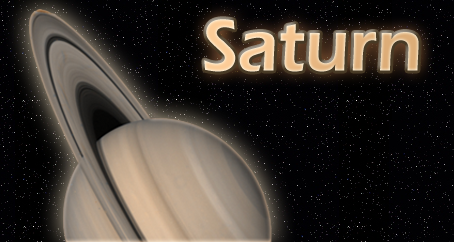Fourteen Facts about Saturn
Fact One
Saturn is the second largest planet in the Solar System after Jupiter. It is so big that Earth could fit into it 755 times.
Fact Two
Saturn is a slightly smaller version of Jupiter, with similar, but less distinctive, surface patterns. Like Jupiter, it is mostly made up of hydrogen and helium gas. Saturn's main difference to Jupiter is the amazing set of rings that orbit it.
Fact Three
Saturn's rings may be particles of an old moon orbiting the planet, smashed apart in a collision millions years ago.
Fact Four
Saturn's rings orbit the planet at different tilts. Sometimes, they can appear like 'ears' sticking out of the planet. At other times, they are flat on when seen from Earth and are hardly visible. This shows how thin they can be.
Fact Five
It is believed that Saturn's rings will one day disappear. They will either disperse (spread out) into space or get sucked into the planet by its pull of gravity. This isn't likely to happen anytime soon, more than likely occurring in ten of millions of years time.
Fact Six
Despite its similarities to Jupiter, there is no great spot on Saturn, although the planet does have stormy weather.
Fact Seven
Saturn is twice as far away from the Sun as Jupiter is.
Fact Eight
Saturn's largest moon, Titan, is the only moon in the Solar System to possess an atmosphere.
Fact Nine
Christiaan Huygens, the Dutch astronomer who discovered Saturn's moon Titan in 1655, also invented the pendulum clock.
Fact Ten
It is thought that Titan's atmosphere is so thick, and its gravity so weak, that humans beings could strap on a set of wings and fly through its skies. Of course, it's too cold to survive there but it's an interesting thought!
Fact Eleven
The first sounds to be recorded from any other world in the solar system were recorded from Saturn's moon Titan by the Huygens space probe in 2005.
Fact Twelve
Saturn has such a low density (meaning that its particles are far apart) that, if there was an ocean big enough, Saturn would float on it. In comparison, Earth and Mercury would sink to the bottom quickest.
Fact Thirteen
A year on Saturn would take almost thirty Earth years. However, a day on Saturn is about 10 and a half hours.
Fact Fourteen
If Earth had rings than spanned as far out as Saturn's, they would reach about three quarters of the way to the Moon.

View facts about other destinations

Saturn Statistics Table
| Name | Saturn |
| Meaning of Name | Saturn was the Roman god of agriculture. Its Greek equivalent is Kronos. |
| Name in Foreign Languages | Saturne (French), Saturn (German, Russian), Saturno (Spanish, Portuguese, Italian), Saturnus (Latin), Kronos (Greek) |
| Average Distance from the Sun |
1,426,725,400 km / 885,904,700 miles / 9.537 A.U. Comparison with Earth: 149,597,890 km / 92,955,820 miles / 1.000 A.U. |
| Closest Distance to the Sun (Perihelion) | 1,349,467,000 km / 838,519,000 miles / 9.021 A.U. Comparison with Earth: 147,100,000 km / 91,400,000 miles / 0.983 A.U. |
| Farthest Distance from the Sun (Aphelion) |
1,503,983,000 km / 934,530,000 miles / 10.054 A.U. Comparison with Earth: 152,100,000 km / 94,500,000 miles / 1.017 A.U. |
| Diameter across equator | 120,536 km / 74,898 miles Comparison with Earth: 12,756 km / 7,926 miles |
| Diagram showing planet's size compared to the size of Earth |
 |
| Circumference around equator |
378,675 km / 235,298 miles Comparison with Earth: 40,074 km / 24,901 miles |
| Mass | 568,510,000,000,000,000,000,000,000 kg Comparison with Earth: 5,973,700,000,000,000,000,000,000 kg |
| Time to spin on Axis | 10 hours, 39 minutes Comparison with Earth: 23 hours, 56 minutes |
| Time to orbit the Sun | 29.4 years Comparison with Earth: 365 days, 6 hours |
| Distance planet travels to complete one orbit | 8,725,000,000 km / 5,421,000,000 miles Comparison with Earth: 924,375,700 km / 574,380,400 miles |
| Gravity (Earth = 1) | .91 |
| Escape Velocity | 127,760 km/h / 79,390 mph Comparison with Earth: 40,248 km/h / 25,009 mph |
| Temperature at Cloud Tops | -178 °c / -288 °F / 95 K Comparison with Earth's average temp: 15 °c / 59 °F / 288 K |
| Contents of Atmosphere | Hydrogen (75%), Helium (25%), traces of other elements like methane, ammonia and water ice. |
| Known moons | There are at least 60 moons known to orbit Saturn - Pan (1981), Daphnis (2005), Atlas (1980), Prometheus (1980), Pandora (1980), Epimetheus (1980), Janus (1980), Mimas (1789), Methone (2004), Anthe (2004), Pallene (2004), Enceladus (1789), Telesto (1980), Tethys (1684), Calypso (1980), Dione (1684), Helene (1980), Polydeuces (2004), Rhea (1672),
Titan (1655), Hyperion (1848), Iapetus (1671), Kiviuq (2000), Ijiraq (2000),
Phoebe (1898), Paaliaq (2000), Skathi (2000), Albiorix (2000), S/2007 S3 (2007), Bebhionn (2004), Erriapo (2000), Siarnaq (2000), Skoll (2006), Tarvos (2000), Tarqeq (2007), Greip (2006), Hyrrokkin (2004), S/2004 S13 (2004), S/2004 S17 (2004), Mundilfari (2000), Jarnsaxa (2006), S/2006 S1 (2006), Narvi (2003), Bergelmir (2004), Suttungr (2000), S/2004 S12 (2004), S/2004 S07 (2004), Hati (2004), Bestla (2004), Farbauti (2004), Thrymr (2000), S/2007 S2 (2007), Aegir (2004), S/2006 S3 (2006), Kari (2006), Fenrir (2004), Surtur (2006), Ymir (2000), Loge (2006), Fornjot (2004) |
| Past Missions (including nationality and year of launch) | Pioneer 11 (USA, 1972) |
| Present Missions | Voyager 1 (USA, 1977), Voyager 2 (USA, 1977), Galileo (USA, 1989), Ulysses (USA/Europe, 1990), Cassini-Huygens (USA/Europe/Italy, 1997). Note that although these are still active missions, all apart from Cassini-Huygens have long since past by Saturn and are at other locations in the Solar System. |
| Proposed or planned Missions | Titan Mare Explorer (TiME) (USA, 2016), Titan Saturn System Mission (TSSM)(USA, Europe, 2020) |
